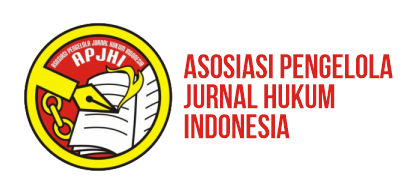Model dan Implementasi Putusan Mahkamah Konstitusi dalam Pengujian Undang-Undang (Studi Putusan Tahun 2003-2012)
DOI:
https://doi.org/10.31078/jk1046Keywords:
Constitutional Court, Judicial Review, Verdict, ImplementationAbstract
Research concerning model and implementation of Constitutional Court Verdicts in Judicial Review of Law against the 1945 Constitution constitutes juridical normative research using secondary data which is primary legal material namely Constitutional Court verdicts issued from 2003 until 2012. This research aimed at identifying decisions of which the dictum say it granted the petition submitted at the Court so that a comprehensive and integrative description of the model and implementation of Constitutional Court verdict can be found out. Article 56 Paragraph (3) and Article 57 Paragraph (1) of Law No. 24 Of 2003 as amended with Law No. 8 of 2011 on the Amendment of Law on Constitutional Court stipulate that in case a petition is granted, the Court will, at the same time, declares that a law is contradictory to the 1945 Constitution either wholly or partially and legally null and void since declard in an open court. This research found out that there are other models of verdict with their own characteristics. Condititonally constitutional and conditionally unconstitutional verdict is basically a model of decisions which do not legally nullify and declare a norm null but these two models contain interpretation of a content of a paragraph, an article and/or part of a law or the whole part of a law which is basically declared contradictory or not contradictory to the Constitution and still have the force of law or do not have the force of law. A limited constitutional model of verdict which postpone an enforcement of a decision which basically aims at providing some time for transition of the provision which has been declared contradictory to the constitution to remain in force until a certain time in the future. Another model of verdict is a decision which formulate a new norm in order to cope with the unconstitutionality of implementation of a norm. This new norm is temporary in nature and will be included in the new law or revision of related law. The implementation of Constitutional Court decision can be inferred from the model of the decisions. A self-executing force can generally be applied to a legally null and void model of verdict and a model of verdict which formulates new norms. Conditionally constitutional, conditionally unconstitutional and limited constitutional model of verdict is non self-executing. This models must go through legislation process either with revision of laws or making of new laws and regulation process for the ordinances made under any acts.
References
Abdul Latif, dkk, Buku Ajar Hukum Acara Mahkamah Konstitusi, Yogyakarta: Total Media, 2009
Burhan Ashafa, Metode Penelitian Hukum, (Bandung: Rineka Cipta 1988) Chirstopher Wolfe, The Rise of Modern Judicial Review, From Constitutional Interpretation to Judge- Made Law, New York: Basic ooks, Inc. Publisher, 1986.
Fatkhurohman, Dian Aminudin dan Sirajuddin, Memahami Keberadaan Mahkamah Konstitusi di Indonesia, PT. Citra Aditya Bakti, Bandung, 2004.
Fatmawati, Hak Menguji (Toetsingsrecht) yang Dimiliki oleh Hakim dalam Pengujian UU, (Jakarta: PT RadjaGrafindo, 2005).
Firmansyah Arifin dan Juliayus Wardi (editor), “Merambak Jalan Pembentukan Mahkamah Konstitusi di Indonesia”, (Kata Pengantar), Cetakan Pertama, Konsorsium Reformasi Hukum Nasional (KRHN), Jakarta, 2002.
H.A.S. Natabaya, Sistem Peraturan Perundang-undangan Indonesia, (Jakarta: Sekretariat Jenderal dan Kepaniteraan Mahkamah Konstitusi, 2006)
Hans Kelsen, General Theory Theory of Law and State (New York: Russel& Russel, 1973) James Mac Gregor Burns, J.W. Peltason, dan Thomas E. Cronin, Government by the
People, 13th alternate ed., (New Jersey: Prentice Hall, 1989)
Jimly Asshiddiqie dan Mustafa Fakhry, Mahkamah Konstitusi: Kompilasi Ketentuan UUD, UU dan Peraturan di 78 Negara, Pusat Studi Hukum Tata Negara FH UI dan Asosiasi Pengajar HTN dan HAN Indonesia, Jakarta, 2002
_______, “Menelaah Putusan Mahkamah Agung tentang ‘Judicial Review” atas PP No. 19/2000 yang bertentangan dengan UU Nomor 31 Tahun 1999,” (tanpa tempat, tanpa tahun)
_______, Hukum Acara Pengujian Undang-Undang, (Jakarta: Sekretariat Jenderal dan Kepaniteran Mahkamah Konstitusi, 2005)
_______, Model-Model Pengujian Konstitusional di Berbagai Negara, cet. 2, (Jakarta: Konstitusi Press, 2005)
_______, Format Kelembagaan Negara dan Pergeseran Kekuasaan dalam UUD 1945, FH UII Press, Yogyakarta, 2004.
_______, Mahkamah Konstitusi dan Cita Negara Hukum Indonesia;Refleksi Pelaksanaan Kekuasaan kehakiman Pasca Amandemen Undang Undang Dasar Negara Republik Indonesia Tahun 1945, artikel pada www.pemantauperadilan. com/09 Desember 2004,10.5
_______, Pokok-Pokok Hukum Tata Negara Indonesia Pasca Reformasi, Jakarta:PT Bhuana Ilmu Populer, 2007
John E. Ferejohn, 2002-2003, Constitutional Review in the Global Context, dalam 6th New York University Journals, Legis. & Pub. Pol’y 49,
Kepaniteraan dan Sekretariat Jenderal Mahkamah Konstitusi, Dinamika Penegakan Hak Konstitusional Warga Negara Laporan Tahunan Mahkamah Konstitusi RI 2012, (Jakarta: Kepaniteraan dan Sekretariat Jenderal Mahkamah Konstitusi, 2013)
Loenard W. Levy, “Judicial Review, Sejarah dan Demokrasi: Sebuah Pengantar”, dalam Leonard W. Levy (Editor), Judicial Review: Sejarah Kelahiran, Wewenang dan Fungsinya dalam Negera Konstitusi, Nusamedia dan Nusansa, Bandung, 2005.
Mahkamah Konstitusi: Kompilasi Ketentuan Konstitusi, Undang-Undang dan Peraturan Di 78 Negara, (Jakarta: Pusat Studi Hukum Tata Negara Fakultas Hukum Universitas Indonesia-Asosiasi Pengajar Hukum Tata Negara dan Hukum Administrasi Negara Indonesia, t.t.)
Maruarar Siahaan, Hukum Acara Mahkamah Konstitusi, (Jakarta: Konstitusi Press, 2010)
_______, Peran Mahkamah Konstitusi dalam Penegakan Hukum Konstitusi, Jurnal Hukum No. 3 Vol. 16 Juli 2009: 357 – 378.
_______, UUD 1945 Konstitusi yang hidup, 2008, Sekretariat Jenderal dan Kepaniteraan MK, Jakarta
Moh. Mahfud MD, Konfigurasi Politik dan Karakter Produk Hukum; Otoriter dan
Konservatif, artikel pada Prisma, edisi 7 Juli 1995
_______, Pergulatan Politik dan Hukum di Indonesia, Gama Media, Yogyakarta, 1999
_______, Politik Hukum di Indonesia, Cetakan Kedua, LP3ES, Jakarta, 2001 Muhajir Noeng, Metode Penelitian Kwalitatif, Edisi III, ,(Yogyakarta: Rake Sarasin, 1998)
Padmo Wahjono, Indonesia Negara Berdasarkan atas Hukum, Cet. 2, (Jakarta: Ghalia Indonesia, 1986)
Rene David dan John E.C. Brierley, Major Legal Systems in the World Today: Introduction to the Comparative Study of the Law, ed. 3rd, (London: Stevens and Sons Ltd., 1996)
Siti Fatimah, Praktek Judicial Review di Indonesia; Sebuah Pengantar, Pilar Media, Yogyakarta, 2005
Soeryono Soekanto dan Sri Pamuji, Metode Penelitian Hukum, (Bandung: Rineka Cipta, 2003)
Sri Soemantri, Hak Uji Materiil di Indonesia, Cetakan Pertama, Edisi Kedua, Alumni, bandung, 1997
Sutandyo Wignjosoebroto. 2006. Hukum: Paradigma, Metode dan Dinamika Masalahnya. (Jakarta: Elsam)
Tim Penyusun Laporan Tahunan Mahkamah Konstitusi 2012, Dinamika Penegakan Hak Konstiusional Warga Negara Laporan Tahun Mahkamah Konstitusi RI 2012, (Jakarta: Kepaniteraan dan Sekretariat Jenderal Mahkama Konstitusi, 2013)
Tom Ginsburg, 2003, Judicial Review in New Democracies: Constitutional Courts in Asian Cases, Cambridge University Press
PUTUSAN PENGADILAN
Putusan Mahkamah Konstitusi Nomor 011-017 PUU-I/2003 Perihal Pengujian Undang-undang Republik Indonesia Nomor 12 Tahun 2003 tentang Pemilihan Umum Anggota Dewan Perwakilan Rakyat, Dewan Perwakilan Daerah, dan Dewan Perwakilan Rakyat Daerah terhadap Undang-Undang Dasar Negara Republik Indonesia Tahun 1945.
Putusan Mahkamah Konstitusi Nomor 013-022/PUU-IV/2006 Perihal Pengujian Kitab Undang-Undang Hukum Pidana (selanjutnya disebut KUHPidana) terhadap Undang-Undang Dasar Negara Republik Indonesia Tahun 1945.
Putusan Mahkamah Konstitusi Nomor 072-073/PUU-II/2004 Perihal Pengujian Undang-undang Republik Indonesia Nomor 32 Tahun 2004 tentang Pemerintahan Daerah (selanjutnya disebut UU Pemerintahan Daerah) terhadap Undang-Undang Dasar Negara Republik Indonesia Tahun 1945 (selanjutnya disebut UUD 1945.
Putusan Mahkamah Konstitusi Nomor 11/PUU-VIII/2010 Perihal Pengujian Undang-Undang Nomor 22 Tahun 2007 tentang Penyelenggara Pemilihan Umum terhadap Undang-Undang Dasar Negara Republik Indonesia 1945.
Putusan Mahkamah Konstitusi Nomor 22-24/PUU-VI/2008 Perihal Pengujian Undang-Undang Nomor 10 Tahun 2008 tentang Pemilihan Umum AnggDewan Perwakilan Rakyat, Dewan Perwakilan Daerah, dan Dewan PerwakilRakyat Daerah terhadap Undang-Undang Dasar Negara Republik Indonesia1945
Putusan Mahkamah Konstitusi Nomor 5/PUU-V/2007 Perihal Pengujian Undang-Undang Nomor 32 Tahun 2004 tentang Pemerintahan Daerah terhadap Undang-Undang Dasar Negara Republik Indonesia Tahun 1945.
MAKALAH DAN RISALAH
Risalah Rapat Panitia Khusus Rancangan Undang-Undang Tentang Pembentukan Peraturan Perundang-Undangan Dewan Perwakilan Rayat Republik Indonesia, Selasa, 01 Maret 2011
Refly Harun, “Implementasi Putusan MK Terhadap Proses Legislasi” dalam Ceramah Perancangan Peraturan Perundang-undangan dengan tema “Implementasi Putusan Mahkamah Konstitusi Terhadap Proses Legislasi”, Direktorat Jenderal Peraturan Perundang-undangan Jumat, 3 Desember 2010.
JURNAL
Anna Rotman, 2004, Benin’s Constitutional Court : An Institutional Model for Guaranteeing Human Rights, Harvard Human Rights Journals, Volume 17, Spring 2004
Bojan Bugaric, 2001, Courts as Policy-Makers: Lessons from Transition, dalam 42nd Harvard International Law Journals, 256
Topane Gayus Lumbuun, Tindak Lanjut Putusan Mahkamah Konstitusi oleh DPR RI, Jurnal Legislasi Indonesia, Vol.6 No.3 September 2009: 498.
Maruarar Siahaan, “Peran Makamah Konstitusi Dalam Penegakan Hukum Konstitusi, Jurnal Hukum No.3 Vol. 16 Juli 2009: 358.
H.M. Laica Marzuki, 2007, Membangun Undang-Undang Yang Ideal, dalam Jurnal Legislasi Indonesia, Vol. 4, No. 2, Juni, Direktorat Jenderal Peraturan Perundang- Undangan Departemen Hukum dan HAM RI, Jakarta
INTERNET
“Arief Hidayat Gantikan Mahfud MD., http://ww.indopos.co.id/2013/03/arief- hidayat-gantikan-mahfud-m-d.html
“Kekuatan Mengikat dan Pelaksanan Putusan MK,” http://anomalisemesta. blogspot.com/2009/02/kekuatan-mengikat-dan-pelaksanaan.html, diakses 23 September 2013.
“Mahkamah Konstitusi Boleh Mengganti Isi UU?”, http://www.hukumonline.com/ klinik/detail/lt4da2b22922b2e/mahkamah-konstitusi-boleh-mengganti-isi- uu?. Diakses 23 September 2013.
Aninditya Eka Bintari, Mahkamah Konstitusi sebagai Negative Legislator dalam Penegakan Hukum Tata Negara, Pandecta, Volume 8. Nomor 1. Januari 2013, http://journal.unnes.ac.id/nju/index.php/pandecta
Mualimin Abdi, Implikasi Putusan Mahkamah Konstitusi terhadap Proses Legislasi di Indonesia, disampaikan Pada Ceramah Peningkatan Pengetahuan Perancang Peraturan Perundang-Undangan Jakarta, 3 Desember 2010
Muchamad Ali Safa’at, Penafsiran Konstitusi, diunduh dari http://safaat.lecture. ub.ac.id/2011/11/penafsiran-konstitusi/, diakses pada tanggal 26 September 2012
Pan Mohammad Faiz, Mengawal Demokrasi Melalui Constitutional Review (Bagian II), dalam http://panmohamadfaiz.com/2009/12/31/mengawal- demokrasi-melalui-constitutional-review-bagian-ii/ diakses tanggal 21 September 2013
Veri Junaidi, Pengujian UU 10/2008 tentang Pemilu Legislatif : Pengaruh dan Tindak Lanjutnya terhadap Pelaksanaan Pemilu 2009 dalam http://verijunaidi. com/2009/12/01/pengujian-uu-102008-tentang-pemilu-legislatif-pengaruh- dan-tindak-lanjutnya-terhadap-pelaksanaan-pemilu-2009/ diakses 19 September 2013
http://www.tempo.co/read/news/2011/11/22/078367789/p-Apa-Kata-Mahfud- Soal-Jual-Beli-Pasal-di-DPR.
Downloads
Published
How to Cite
Issue
Section
License
Authors who publish with this journal agree to the following terms:
- Copyright of the published articles will be transferred to the journal as the publisher of the manuscripts. Therefore, the author confirms that the copyright has been managed by the publisher.
- The publisher of Jurnal Konstitusi is The Registrar and Secretariat General of the Constitutional Court of the Republic of Indonesia.
- The copyright follows Creative Commons Attribution-NonCommercial-ShareAlike 4.0 International License: This license allows reusers to distribute, remix, adapt, and build upon the material in any medium or format for noncommercial purposes only, and only so long as attribution is given to the creator. If you remix, adapt, or build upon the material, you must license the modified material under identical terms.

















